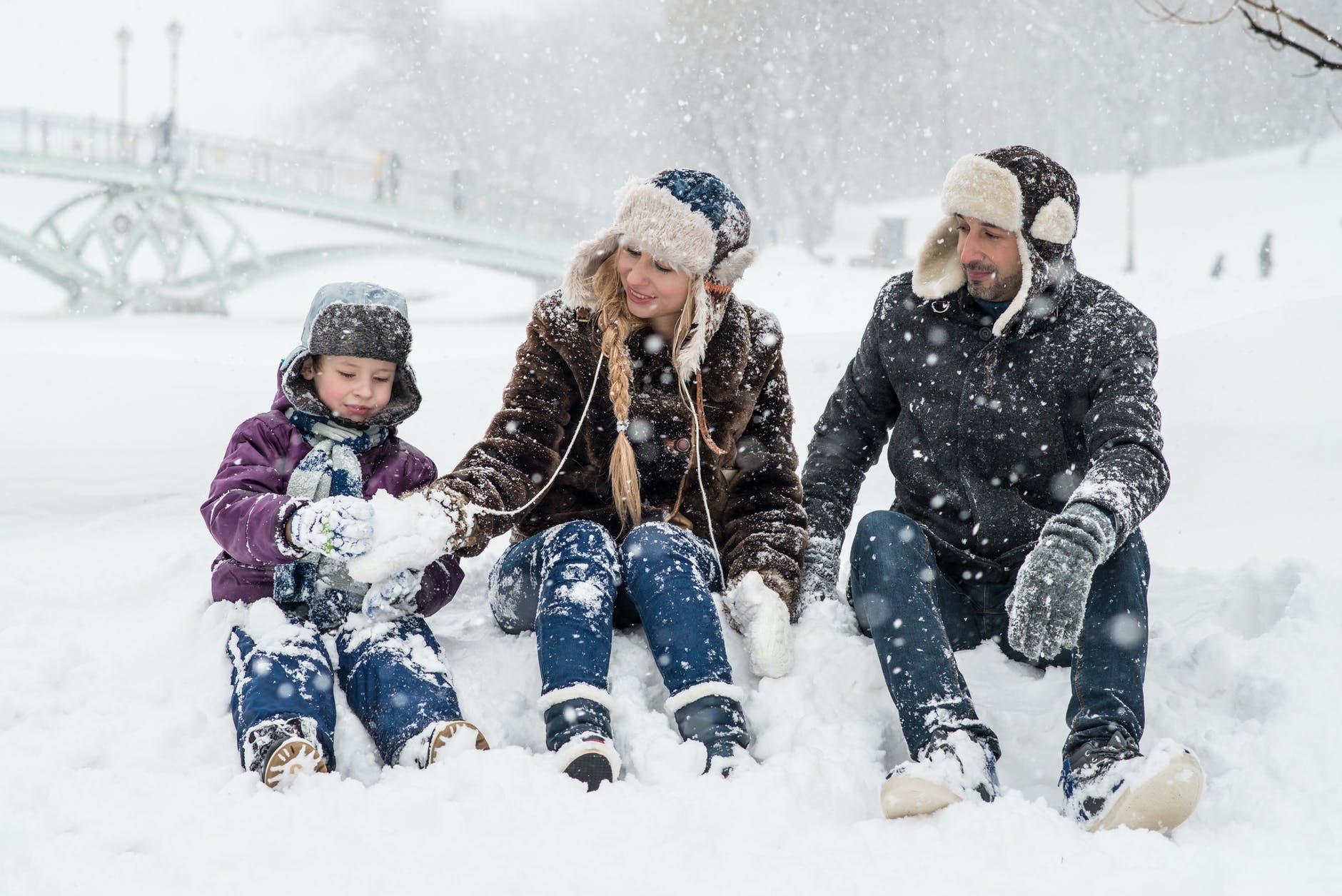We are definitely ready for Elsa to bring back summer, but in the meantime, enjoy the health benefits of just being outside in the fresh air; it’s an easy way to promote the overall development of your children. Providing these opportunities to play outside naturally engages their senses, speech, and motor development at the very least.

Facilitate Development
The Sunshine Vitamin, brought to you by Nurture Notetakers Alison Unger, a Registered Dietitian and Danielle Kinney, a Pediatric and Integrative Nutrition student.

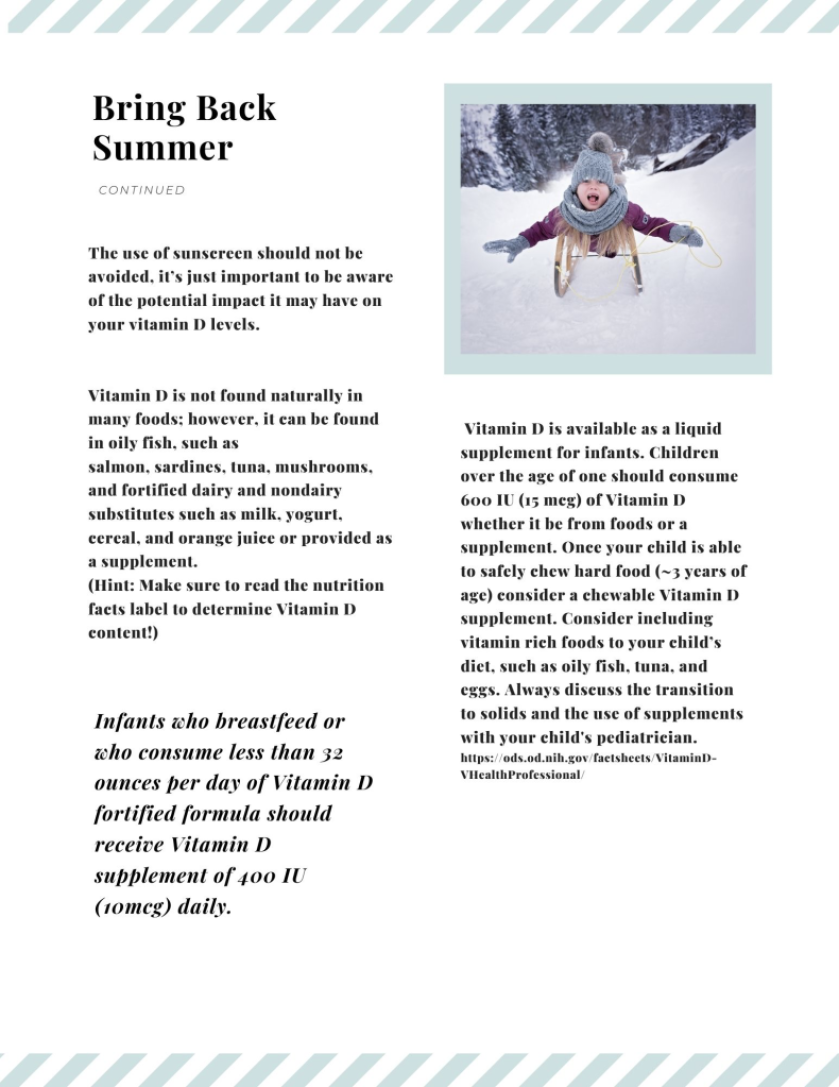
Imaginative Play
Let’s start with imaginative play. Social, cognitive, and speech and language skills develop through pretend play. An abundance of teaching moments may be built into imaginative play time to promote creativity and problem-solving skills. Let your child take the lead, have fun, and go with it. If they have a favorite character, such as Elsa or Kristoff, that may make it easier too. Using a page from one of their favorite books or a scene from a movie can help get you started. The little Elsa above loves singing, dancing, and walking in the snow to the song Let it Go so we started out with that, then made Olaf and “Olaf asked her if she could bring back summer.” Pretend play doesn’t necessarily come easy for everyone and that’s ok. Your child will just love the time you are spending with them.
Bring Winter Indoors
Sometimes (or all the time), your child wants to go out to play in the snow, and you want to stay in. I’m not a fan of the cold myself but the good news is your child can still really benefit from pretend play in the snow even inside.
How cool is this! When your child wants to bring winter indoors, just lay a mat down, grab a water table or a big plastic bin, and let them dig and play.
Indoor Snow Play
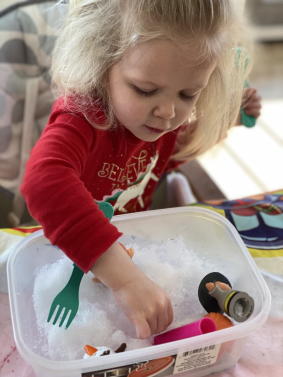
If your child likes to leave a mess everywhere they go then simply use their highchair or booster seat at a table. Use a small bin of snow, place a mat under it, and give them their favorite waterproof toys.
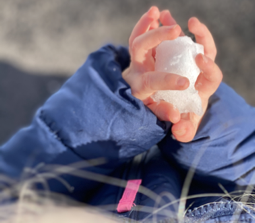
Make Snowballs
When your child makes a snowball it facilitates bilateral hand integration, which is the use of both hands together to complete a task. Your child is also learning about their proprioceptive sense, where their body is in space. They are learning to grade pressure as they test how hard they need to push their hands together.

Pet Snowball Toss
Be sure to include your pets in the action and by tossing some snowballs their way. They love to be in on the action, so toss some snowballs their way. Playing with pets should always be supervised. According to the NCBI, safe “Companion animals (including horses, dogs, cats, rabbits, and other rodents) have the potential to promote healthy emotional youth development in many ways.” Youth in this article refers to all ages from 0-18 years old and the NCBI further concludes that “Current evidence suggests that overall, pet ownership may be beneficial to child and adolescent emotional, cognitive, behavioral, educational and social development.” https://www.ncbi.nlm.nih.gov/pmc/articles/PMC5369070/#sec1-ijerph-14-00234title

Snow-hole Toss
To play this snowy version of a bean bag game simply use things you have around your house. We have cones that are used to practice sports and they worked perfectly. However, you could reuse plastic containers you already have. Take turns tossing the snowballs in the cones or containers or just aim and throw at one target (i.e. a Frisbee placed in the snow). This game facilitates eye-hand coordination and motor planning.
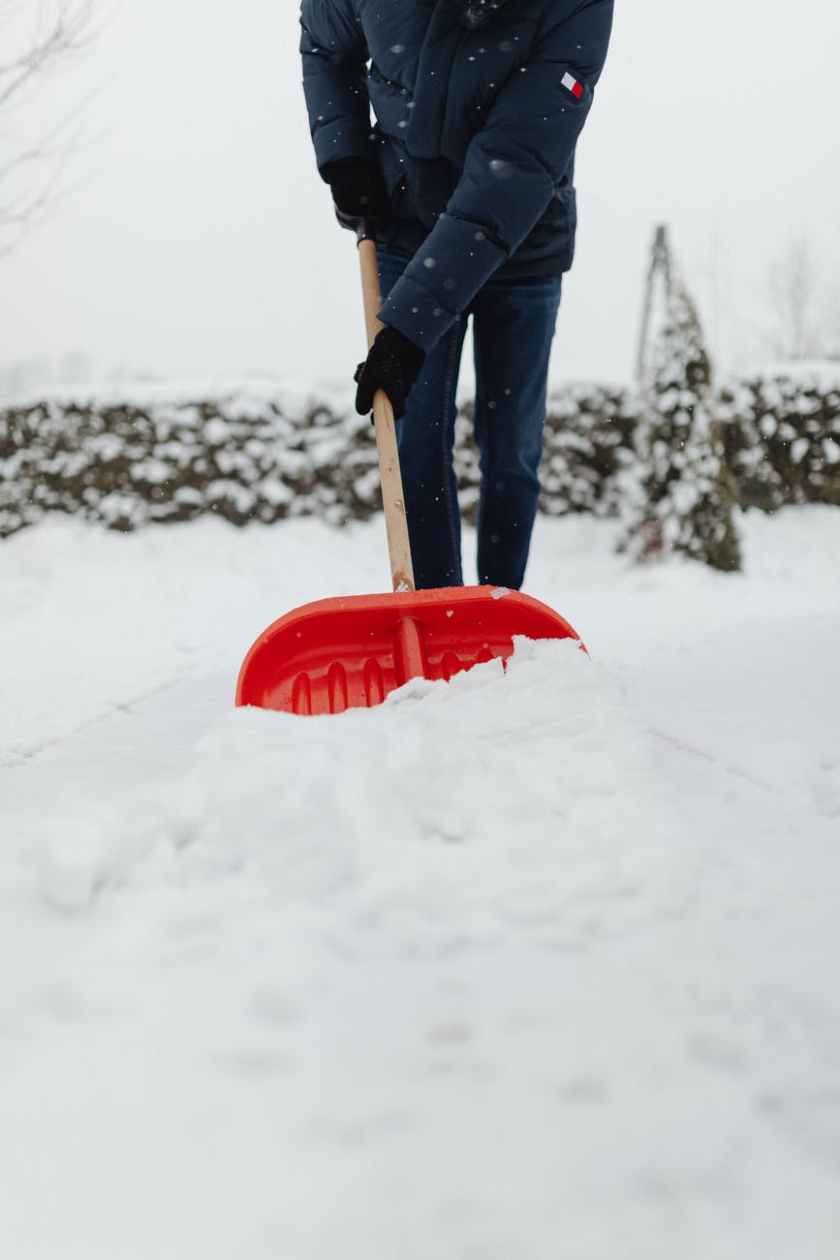
Snow Slide
Use a mound of packed snow to create a slide. Climbing up the miniature hill and sliding down is great for strengthening muscles, gross motor coordination, and stimulating the vestibular sense. This is a miniature version of sledding down a big hill, which younger children may get less physical activity from since often parents end up carrying our children up because they can’t make it themselves. Climbing up the hill and sliding down it is great for strengthening muscles, gross motor coordination, and stimulates the vestibular sense. Don’t forget snowboarding. That is always fun!

Sled Push
Give your child some healthy push challenges. Pushing and pulling objects in a safe way will strengthen and coordinate your child’s large muscle groups. This little one was motivated to push a friend down a small hill. I bet she slept well that night.

Build a Snowman
We love to make snowmen in the front of our house as lawn ornaments. Making a snowman encompasses many developmental skills that you may have never even considered. It promotes body awareness in children, which is actually a pre-writing skill, as they have to identify the different parts of the snowman. Building a snowman facilitates creativity, problem-solving, visual motor, and visual perceptual skills as your child thinks of items that may be used to make the different parts of the snowman. Not to mention all the big muscle movements they will be using while making while making the body or be making while constructing the body and pushing the parts around. You can even strengthen their hands while adding color to your winter snowman. Grab a spray bottle, add water, add a couple drops of food dye, mix, and spray a shirt or heart on the snowman. Squeezing a spray bottle strengthens your child’s hands. Or even use one of the juice cube hearts you may have made back from our Valentine’s Day blog. Put peanut butter (or a peanut butter substitute) on a pinecone and roll it in birdseed to hang from the snowman’s arm. If your child is old enough to work on writing skills they can make a sign to hang between the snowman’s hands. Have fun and be creative!
Snow Angels
Snow angels seem simple but think about the amount of coordination a child needs to be able to move both arms and legs synchronously. Adding snow angels to your winter bucket list will be fun while facilitating development of motor planning.
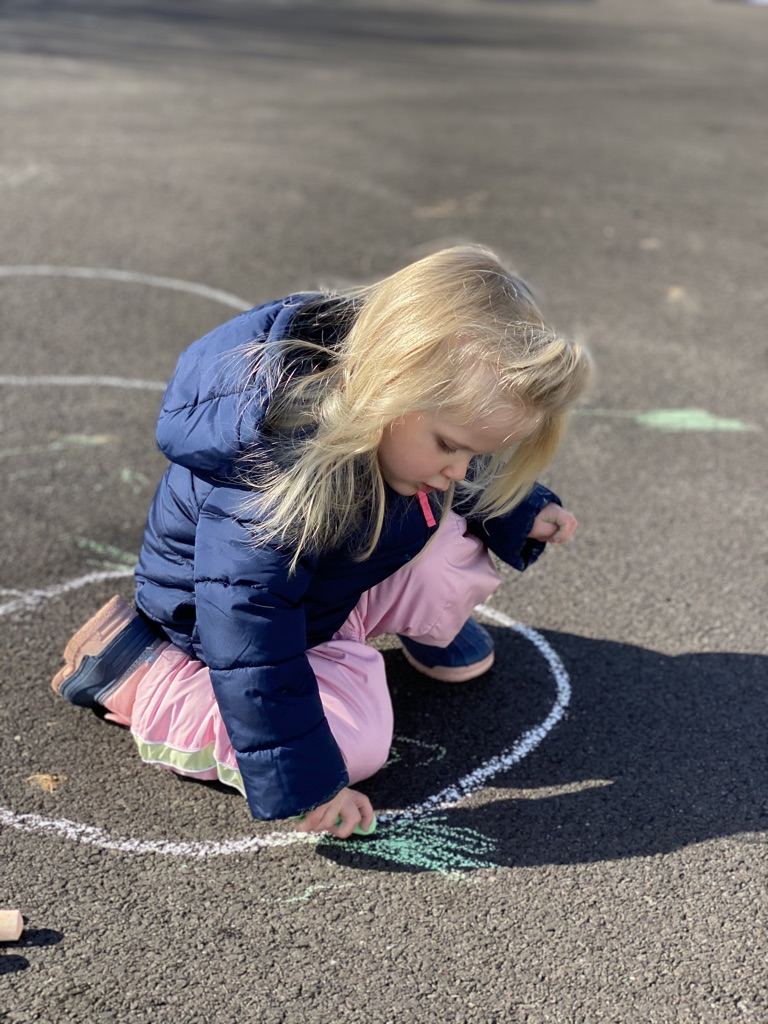
Sidewalk Chalk Snowman
Are you still bored? Grab some chalk and draw a snowman or snowflakes. Using chalk promotes eye-hand coordination, body awareness, visual motor, and fine motor skills. Sing Head, Shoulders, Knees, and Toes or a winter song. Or change up the Mat Man song from Learning Without Tears and create your own Snowman song. Mat Man Learning Without Tears (LWT) song promotes body awareness. https://www.youtube.com/watch?v=8O_vUHG7440
https://www.lwtears.com/blog/meet-mat-man

Play-dough Snowman
Playing with play-dough develops fine motor skills and provides nice tactile and proprioceptive input through little fingers.
This is the way Nurture Notetaker, Kim Bandi adapts LWT Mat Man song when she is making a snowman with her children:
Snowman Song
Snowman has 1 head, 1 head, 1 head. Snowman has 1 head, so that he can think.
Snowman has 2 eyes, 2 eyes, 2 eyes. Snowman has 2 eyes, so that he can see.
Snowman has 1 nose, 1 nose, 1 nose. Snowman has 1 nose, so that he can smell.
Snowman has 1 mouth, 1 mouth, 1 mouth. Snowman has 1 mouth, so that he can speak.
Snowman has 2 ears, 2 ears, 2 ears. Snowman has 2 ears, so that he can hear.
Snowman has 1 chest, 1 chest, 1 chest. Snowman has 1 chest, for you to place his heart.
Snowman has 2 arms, 2 arms, 2 arms. Snowman has 2 arms, for giving great big hugs.
Snowman has 1 bottom, 1 bottom, 1 bottom. Snowman has 1 bottom, to hold the rest of him up.
Snowman has 2 boots, 2 boots, 2 boots. Snowman has 2 boots, to frolic in the snow.

Snowy Day Books
The Snowy Day by Ezra Jack Keats is worth repeating again from our last blog because it is a great book for speech and language development.
As you watch the snow melting over these next several weeks we hope you get to enjoy some more snow play with your children.
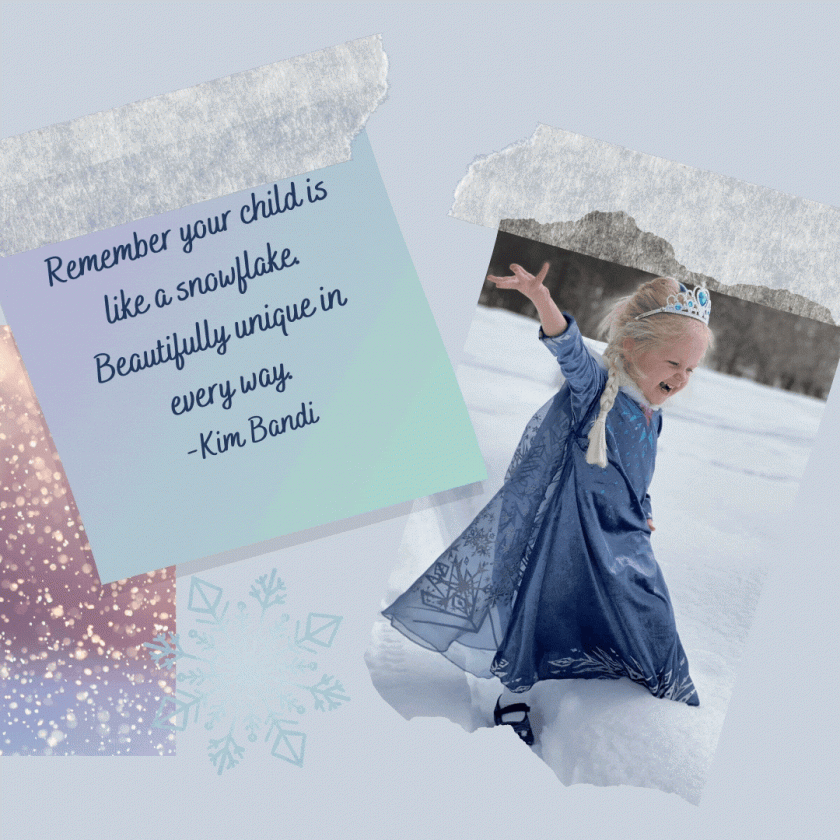
Love, Your Nurture Notetakers
